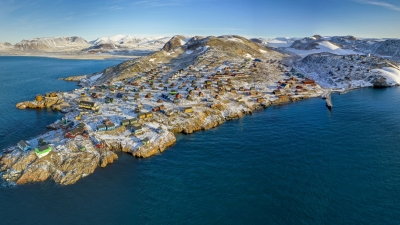
Greenland is the world’s largest island. While Australia is an island, it is considered a continent. Greenland has an area of 2,166,086 square km, but a meager population of 56,452. The populations is over 85% Inuit. The remaining inhabitants are mainly Danish. The average annual temperature of Greenland varies between -9 to 7 °C.
Greenland is an autonomous country within the Kingdom of Denmark. Greenland is a group of islands and Greenland is the name of the largest, most populated one. Greenland has been inhabited on and off since 2500 BC. Denmark established rule in the 18th century. In 1979 Denmark granted home rule, in a relationship known as the Commonwealth of the Realm and in 2008 Greenland voted to transfer more powers to the local government. The Danish royal government is only in charge of foreign affairs, security, financial policy, and providing a subsidy to each citizen.
Greenland is bordered by the Atlantic Ocean to the southeast, the Greenland Sea to the east, the Artic Ocean to the north, and Baffin Bay to the west. The nearest countries to Greenland are Iceland to the east and Canada to the west. The country also contains the world’s largest national park. Scientists have thought for decades that the ice sheet covering the country may actually conceal three separate island land masses that have been bridged by glaciers over the last geologic cooling period.
The Greenland ice sheet covers 1,755,637 square km. It has a volume of 2,850,000 cubic km. Gunnbjorn Fjeld is the highest point on Greenland at 3,700 m. The majority of Greenland is less than 1,500 m in elevation. The weight of the ice sheet has formed a basin that is more than 300 m below sea level.
Between 1989 and 1993, climate researchers drilled into the summit of Greenland’s ice sheet, obtaining a pair of 3 km ice cores. Analysis of the layering and chemical composition of the cores has provided a revolutionary new record of climate change going back about 100,000 years. It illustrated that the world’s weather and temperature have often shifted rapidly from one stable state to another. The glaciers of Greenland are also contributing to a rise in the global sea level at a faster rate than was previously believed.
Credit : Universe Today
Picture Credit : Google




